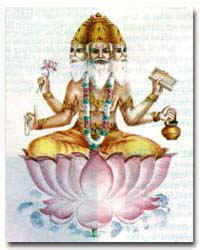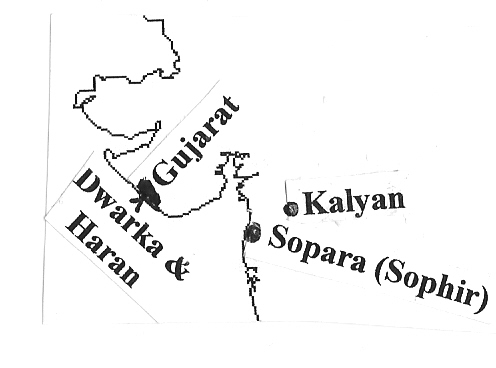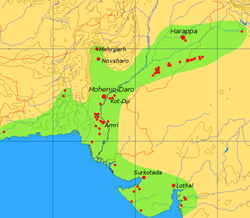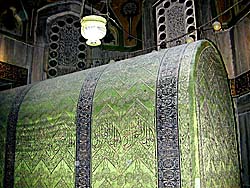St. Augustine of Hippo (354-430 AD) wrote: "This, in our day, is the Christian religion, not as having been unknown in former times, but as having recently received that name."
Eusebius of Caesarea (circa 283-371 AD) said: "The religion of Jesus Christ is neither new nor strange."
In Anacalypsis, The 17th century British orientalist and iconoclast, Godfrey Higgins, insisted that Christianity was already firmly in place in both the West and the East, many centuries before Jesus Christ was born. He said, The Crestians or Christians of the West probably descended directly from the Buddhists, rather than from the Brahmins. (Vol. 2, pp 438, 439.)
The existence of the Christians both in Europe and India, (existed) long anterior to the Christian era... (Vol 2, p. 202.) I think the most blind and credulous of devotees must allow that we have the existence of the Cristna of the Brahmins in Thrace, many hundred years before the Christian era-the birth of Jesus Christ. (Book X, p. 593.)
"Melito (a Christian bishop of Sardis) in the year 170, claims the patronage of the emperor, for the now so-called Christian religion, which he calls "our philosophy," on account of its high antiquity, has having been imported from countries lying beyond the limits of the Roman empire, in the region of his ancestor Augustus, who found the importation ominous of good fortune to his government." This is an absolute demonstration that Christianity did not originate in Judea, which was a Roman province, but really was an exotic oriental fable, imported from India, and that Paul was doing as he claimed, viz: preaching a God manifest in the flesh who had been "believed in the world" centuries before his time, and a doctrine which had already been preached "unto every creature under heaven." (Bible Myths and Their Parallels in Other Religions; T. W. Doane, p. 409.)
Religious historians have for hundreds of years struggled to find out how and why the stories about Jesus and Krishna, who were born 2,000 years apart, are so nearly identical.
- Both Christ and Krishna descended from Noah.
- The future births of both messiahs were predicted ahead of time.
- Christ was descended from Abraham
- Krishna was the father of Abraham (Brahma).
- Christ was at once a Koresh, a Hebrew, and a Yehudi.
- Krishna was at once a Kurus, an Abhira, and a Yadava.
- Christ was an incarnation of Yah-Veh.
- Krishna was at once an incarnation of Vishnu and Shiva.
- Christ's first name, Jesus, was Yeshua.
- A title of Krishna, meaning "love; devotion," was Yesu. Even today, many Hindu parents name their sons, Yesu Krishna.
- Both men were born of virgins and in a stable.
- Krishna's mother was named Devaki.
- Jesus mother was called Mary.
- Krishna did not have an earthly father as such, but a protector, named Vasudeva.
- Jesus did not have an earthly father as such, but a mortal protector named Joseph.
- An evil king tried to kill Christ and Krishna when they were both infants.
- To protect the infant Jesus, Joseph and Mary took him to Maturai, Egypt.
- To protect the infant Krishna, his parents, Vasudeva and Devaki, took him to Mathura, India.
- It was predicted that both men would die to atone for the sins of their people.
- As you have probably noticed, they took refuge in places having almost identical names.
- Both men preached to their people.
- Christ was crucified and then resurrected. Krishna was killed by a hunter's arrow and impaled on a tree. Later, he returned to life.
- Christ was crucified in Jerusalem.
- Some Hindu scholars think that Krishna died in Jerusalem, having gone there when his coastal city of Dwarka sank under the sea. Others say he went to Iraq.
- Christ appeared after his "death." Krishna appeared after his "death."
- Both of them have a major holiday dedicated to them on December 25th.
- Christ had a female admirer named Mary Magdalene. Krishna had a female admirer named Marya Maghadalena.
Fanatically sectarian Christians and Hindus alike militantly reject the idea that the stories of these two deities are related. The Christians accuse the Hindus of blurring their identities on purpose. Some even claim that the Devil himself is the culprit.The Hindus reciprocate accordingly. Unfortunately, neither side can prove or disprove anything. In this article, I will attempt to clear up this mystery once and for all.
The Hindu Equivalent of our Old Testament Story of Abraham.
The story begins with our Abraham or Brahma as the Hindus called him. His father was Lord Krishna; his brother was Mahesh a.k.a Maheshvara who would be our Moses (Heb: Moshe).
The Hindu triad consists of the Gods Brahma, the equivalent of our God, and Gods Shiva and Vishnu. Actually Shiva and Vishnu are one and the same deities. Together, they are Brahma (God). Today, in India, there are only two temples dedicated to God Brahma because the Hindus say mankind is not yet ready to worship such a lofty concept.
Hindu Proof That Jesus Is the Son of God!
The Bible tells us that Jesus was both Shiva and Vishnu, for Jesus' biblical names are Isa/Isha(Shiva), Yeshua (Skt. Yishvara, pronounced in Sanskrit as Yeshwara), Kristos, and Yesu, another name of Krishna . Even in India, Lord Krishna was and still is called Yesu Krishna and Kristna. These names prove to us that Jesus was both Shiva and Vishnu, thus making Jesus the begotten son of the Unbegotten-Brahma.

Picture of Christ.
The preceding information shows us that the Hindus are as Christian as the Christians are. Morever, the Hindus can prove that Jesus was the son of God, but we have to accept this as a matter of faith only. Even so, there is no lack of Christian sects wanting the Hindus to "convert" to their way of thinking although we must credit the Hindus with the honor of proving to us that Jesus is the son of God. But the Hindus don't need to convert to the spiritual knowledge they bequeathed to us. They were "converted" thousands of years before our Jesus was born. I say, leave them be.
Since Krishna was not born of man, he was not actually the earthly father of Brahma and Mahesh. Therefore, he himself was the protector (Tara) of Brahma. In Sanskrit, Tara means "savior; protector." It is a term generally used with the gods Rudra, Shiva, Vishnu and Brahma. Even our Old Testament says that the father (protector) of Abraham was Terah(Genesis 11:26.) The Bible tells us that Abraham and Sarah were half-siblings. (Genesis12:19-20.). The Hindu holy books also tell us that a blood relationship existed between them. The Puranas relate Sarasvati to Brahma and Vishnu. Most frequently, she is associated with Brahma. Her connection with him dates earlier than to any other God. She is portrayed mostly as his wife and occasionally as his daughter. When Vishnu's popularity in India increased, myths relating Saraswati to him appeared. (Ref: Sarasvati and the Gods; www.vishvarupa.com.) Therefore, Brahma or Vishnu would also have been the Tara (Terah) of Sarasvati because of her divine origins.

Brahm (Abraham)

Sarasvati (Sarah)
Abraham or Brahma's home was the land of Haran (Genesis 1:4.) Haran was the coastal principality governed by Krishna. It was even named after him because Hara (Sun God) is another name of Krishna. Brahma/Abraham was 75 years old when he left Haran.
Just as Christ was crucified on a cross and then returned to life, Krishna, also known as Haran, was crucified on a tree and then returned to life. This fact appears to cause some confusion in The Bible. (Read Genesis 11:26-31).
There is also another "Haran" in India-today's state of Haryana. It is the region where Abraham decided to stop making idols and worship only one God. Brahmavarta, a region in Northeastern Haryana, is said to be the place where mankind was first created. (Varta=Dwelling.) Brahmavarta was the site of the Kuruksetra War between the Kurus and Pandavas, in which Lord Krishna distinguished himself. An ancient and holy river, now dried up, the Sarasvati, once flowed through Brahmavarta. The Hakra (the biblical Haggar) was a tributary of the Sarasvati. The relationships of these three geographical entities make sense. If Brahma provided the channel or bed for the Sarasvati river, Brahmavarta could easily have been the symbolical father or brother of Sarasvati. Hakra (Haggar), being a tributary of Sarasvati, depended on Sarasvati . So what were Abraham, Sarah, and Haggar? People, things, or places?

Map of India, showing Haryana

Map showing Brahmavarta
I have stated that the Bible mentions Haran and Haryana. The Hindu holy books also say that Brahma/Abrahan lived in Ur of the Chaldees. Ur was a Sumerian name for "town; city." Chaldee (pronounced Kaldee) derives from the Sanskrit Kaul, a Brahman caste, and Deva (demi-god). The North Indian Kauldevas worshiped idols representing their ancestors. According to the Hindus, Brahma married Sarasvati in Chaldea, the part that is now Afghanistan.
Northern Afghanistan was called Uttara Kuru and was a great center of learning. An Indian woman went there to study and received the title of Vak i.e. Saraisvati (Lady Sarah). It is believed that Brahm, her teacher, was so impressed by her beauty, education, and powerful intellect, that he married her. (The Hindu History, by Ashkoy Kumar Mazumdar; p. 48, in passim.) Lord Krishna, the divine father (Terah/T‚ra) of Brahma/Abraham, was the king of Haran, with the seaport of Dwarka as its capital.
In about 1900 BC, hundreds of thousands of native Indians emptied Northern and Central India and fled to the Middle East after Krishna's Dwarka sank under the water.

Krishna gathered his family together and fled either to the Middle East or to what is now Iraq. Only some gigantic natural disasters, such as earthquakes and floods could have caused such an exodus. It was at this time that the Saraisvati and the Indus changed their proper beds. The Saraisvati dried up.

Map showing the path of the Sarasvati before it dried up.
The drying up of the Saraisvati... led to a major relocation of the population centered around the Sindhu and the Sarasvati valleys... caused a migration westward from India. It is soon after this time that the Indic element begins to appear all over West Asia, Egypt, and Greece. (Indic Ideas in the Graeco-Roman World, by Subhash Kak, taken from IndiaStar online literary magazine; p. 14.)
And Joshua said unto all the people, Your fathers dwelt... in old time, even Terah, the father of Abraham, and the father of Nachor, and they served other gods.
Many people don't understand what is meant by Joshua's remark about "the other side of the flood."
And Joshua said unto all the people, Your fathers dwelt... in old time, even Terah, the father of Abraham, and the father of Nachor, and they served other gods.
And I took your father Abraham from the other side of the flood, and led him throughout all the land of Canaan... (Joshua 24:2-3.)
Many people don't understand what is meant by Joshua's remark about "the other side of the flood." They think he was referring to the Noachide flood. He was referring to the time when God Krishna's Dwarka and Haran province, in today's Gujarat, sank under water in about 1900 BC. Abraham, Sarah, and their followers escaped southward, to the coastal ports of Kalyan and Sopara (Sophir or Sauvira), in Maharashthra. From there, they sailed northward to the Middle East. Sarah (Sarsvati) embarked from the port of Kalyan. At one time, Kalyan was located closer to the coast, but is now located more than 50 miles inland. Sarasvati is the patron saint of Kalyan. The patron saint of Sophir or Sauvira was Parasu Rama (possibly a name of our biblical Abraham/Brahma).
And I took your father Abraham from the other side of the flood, and led him throughout all the land of Canaan... (Joshua 24:2-3.)
Indian Author Paramesh Choudhury, author of The India We Have Lost, claims that Krishna and his family probably fled to Iraq. But I'm certain that they went to Jerusalem. The word Jerusalem is derived from Sanskrit: Yadu-Ishalayam, meaning "The Holy Rock of the Yadu Tribe." Lord Krishna was a Yadu. The Moslems still revere this huge rock under the Dome of the Rock on Jerusalem Temple Mount.


Temple [top] Mount and Dome of the Rock. [bottom] Abraham's tomb.
Until now, I have been wondering why Krishna's name did not appear in Jerusalem after his arrival there. Yet, the name of the king of Jerusalem, Melchizedek, the mentor of Abraham, did. I once thought that Melchizedek was the name of a certain person. I made this mistake by thinking that a prince and a son of a Kassite king, Melik-Sadaksina, was a supernaturally endowed prince, magician and spiritual giant. I thought he had accompanied Krishna, Abraham, and Sarah to the Middle East. Later on, I came to realize that the Sanskrit wordSadhaka applies to anyone who is an adept, a magician, one possessed of supernatural powers gained by worshipping a deity or by uttering magical chants.
I have additionally shown in this article that the New Testament words for Jesus all refer to Lord Krishna and his holy names. The early Christians were convinced that Melchizedek was just a prior incarnation of Jesus Christ, The remains of the Nag Hammadi manuscript entitledMelchizedek seem to confirm this. Melchizedek, king of Jerusalem and mentor of his son Abraham, was none other than ancient India's God Krishna. The early Christians thought that Jesus was a reincarnation of Krishna, for who else had the name Yesu Kristna, Isa, Krishna, etc.?
St. Paul states in the New Testament book of Hebrews:
Whither the forerunner is for us entered, even Jesus, made a high priest forever after the order of Melchisedec. (6:20.) For this Melchisedec, king of Salem, priest of the most high God, who met Abraham returning from the slaughter of the kings, and blessed him...(7:1); For he was yet in the loins of his father when Melchisedec met him. (7:;10);...what further need was there that another priest should arise after the order of Melchisedec...(7:11); Thou art a priest forever after the order of Melchisedec (7:17);.

Melchisedek (Krishna)
In closing this article, I want to mention the dissatisfaction I have always had with fanatical religious sectarians who yell that only they are right and that everybody else is wrong. They often insult, deprecate, mock, and reject those with whom they disagree, hoping to shut the formers' mouths. In many cases, these religious squabbles over suspected "differences" cause widespread bloodshed and misery in the world. I am a Roman Catholic and proud of it. But it grieves me when I hear priests, nuns and laity preach that anyone who isn't a Catholic is hell-bound.
The word "Catholic" itself derives from the Sanskrit Ketu-Loka, meaning "Universal Leader." But how can a religion be "universal" if it is exclusive, locking out nations like India who not only gave Catholics their own bible, but even the Christ they worship? I have shown how nearly parallel our bible and the Hindu holy books concur in almost every way-linguistically, culturally, spiritually, etc. Even the incestuous relationship between Brahma and Sarasvati squares with that of Abraham and Sarah. India more than qualifies to be the real holy land of all mankind. The main differences between Christians and Hindus arise from the fact that the Hindu form of Christianity stayed behind in India, and that the western Christianity we know was exported abroad. Naturally, geographical separation has caused some variations in the two similar teachings, as well as culturally. Additionally, we have to keep in mind that for many hundreds of years, these stories were passed down orally, from father to son. Changes, embellishments, and varying opinions crept through the woodwork.
It is a strange anomaly that our Christian sects want to convert the Hindus to the same religious teachings the latter gave to the world and still practice!
I have amply demonstrated that all of us, no matter what our respective religions and nationalities, are grandchildren of India, Will this knowledge help keep us from tearing ourselves and the world apart?
Addendum:
If, until now, you are still unconvinced that Melchizedek was Lord Krishna, and that Jesus was an incarnation of Krishna (Melchizedek) as Paul himself explained, I have no other recourse but to give you solid proof directly from the mouths of the Hindus themselves! This should put an end to the question. It is a verifiable fact that one of the names of Krishna was Sadhaka. Being a king, Krishna would have been addressed as Malika (King) Sadhaka). If you are still doubtful, go to the web and type in Krishna Sadhaka. You'll instantly get all the proof you'll; ever need. Note: This article is a chapter from Gene's upcoming book, now in preparation: Searching for God -- Now a Valid Science! It will be released in autumn, 2007.

















 Every day we have the opportunity to do anything we want.
Every day we have the opportunity to do anything we want. 










 To avoid these shaving problems, again, shave "with the grain" (that is, in the direction your hair grows). Each person's facial hair has its own growth pattern. If you are unsure of the direction of your beard, let it grow for a day or two and you'll see it.
To avoid these shaving problems, again, shave "with the grain" (that is, in the direction your hair grows). Each person's facial hair has its own growth pattern. If you are unsure of the direction of your beard, let it grow for a day or two and you'll see it.